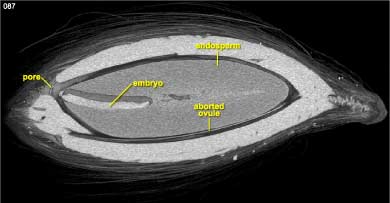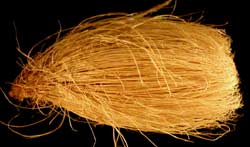|
|
 Expert annotations for this species! See below. Expert annotations for this species! See below.
Syagrus flexuosa, or the Coco Do Vaquiero as it is locally called in Brazil, belongs to a genus of 32 species distributed in South America (one species in the Lesser Antilles). Certain species are conspicuous components of several Brazilian arid vegetation types such as 'cerrado' and 'campo rupestre'.
The genus Syagrus is closely related to the coconut palm; indeed, the species shown here was originally described as Cocos flexuosa by Martius in 1826. This fruit really does look like a miniature coconut, with its hard shell (endocarp) covered by thick brown fibres and the three circular spots ('eyes' or íporesí) at the bottom. The longitudinal fibres are only visible because the outer husk of the fruit (the smooth skin or exocarp, and parts of the pulp or mesocarp) has been removed; originally, the fruit was smooth just like a coconut harvested directly from the tree.
In the CT imagery you can see the most important morphological details of this fruit.
Syagrus is a monoecious palm, which means that it produces unisexual flowers with both sexes on the same plant. The female flowers have a superior ovary with three chambers (locules), each bearing one anatropous ovule. The ovules are attached to the central wall of the locules. After pollination and fertilisation, one of the ovules develops into a seed while the other two are aborted. The ovary develops into a one-seeded fruit with a smooth and thin exocarp (the 'skin' of the fruit, no longer present in the specimen shown here), a dry, spongy, fibrous mesocarp and a very thick, hard endocarp or shell. This type of fruit can be described as a 'dry' drupe or more precisely as a 'nuculanium' (Spjut, 1994).
 |
 |
|
Figure 1. Click for larger image. |
Figure 2. Click for larger image. |
When examined from the outside, the fruit shows three circular spots hidden underneath the longitudinal mesocarp fibres. These 'pores' mark openings in the endocarp. The slightly beaked apex of the fruit bears the remains of the stigma, the complicated internal structure of which can be seen in the animations above. As one dives into the internal structure of the fruit (Figure 1), the first layer to appear directly underneath the fibres is the endocarp, which is traversed by fibrovascular bundles visible as black voids in the otherwise nearly white tissue. The endocarp provides mechanical protection of the seed, allowing the actual seed coat to become rudimentary; it is barely discernable in the CT images and only present as a thin brown envelope covering the nutritional tissue of the seed, the endosperm. Embedded in the endosperm is the embryo (Figure 2), a long white finger-like structure extending from the base up more than a third of the length of the seed. Note that the embryo lies directly below one of the pores that acts as an 'escape hatch' during its germination. Apart from the cavity bearing the embryo, the endosperm shows another, smaller cavity in its centre. The two aborted ovules extend as narrow collapsed tape-like structures along the entire length of the fruit, each with its own pore.
Other fruit on DigiMorph: Ananas comosus


About the Species
The specimen shown here comes from a commercial source (Palm Centre, Richmond, Surrey, UK) and was scanned for Dr. Wolfgang Stuppy of the Royal Botanic Gardens, Kew, UK. Funding for scanning was provided by a National Science Foundation Digital Libraries Initiative grant to Dr. Timothy Rowe of The University of Texas.
It is part of a batch used in a screen of palm seed storage behaviour within a new project, ‘Semina Palmarum’ carried out at the Millennium Seed Bank of the Royal Botanic Gardens, Kew. The project investigates the potential of long term seed storage as a tool for the conservation of rare and threatened palm species. 
A photo of the specimen. Click for a larger version.

About this Specimen
This specimen was scanned by Richard Ketcham on 27 March 2002 along its long axis for a total of 526 512x512 pixel slices. Each slice is 0.0669 mm thick, with an interslice spacing of 0.669 mm and a field of reconstruction of 21 mm. 
About the
Scan
Literature
Balslev, H., and M. Moraes. 1989. Sinopsis de las Palmeras de Bolivia. AAU Reports 20:1-107.
Spjut, R. W. 1994. A systematic treatment of fruit types. Memoir of the New York Botanical Garden 70:1-182.
Stuppy, W. H., Maisano, J. A., Colbert, M. W., Rudall, P. J., and T. B. Rowe. 2003. Three-dimensional analysis of plant structure using high-resolution X-ray computed tomography. Trends in Plant Science 8:2-6.
Uhl, N. W., and J. Dransfield. 1987. Genera Palmarum: a classification of palms based on the work of Harold E. Moore, Jr. Allen Press, Lawrence, Kansas.

Literature
& Links
None available.

Additional
Imagery
|
|








 Expert annotations for this species! See below.
Expert annotations for this species! See below.

